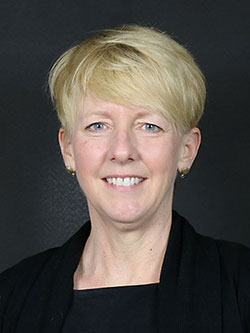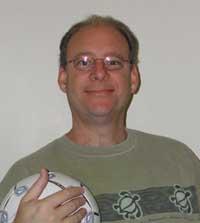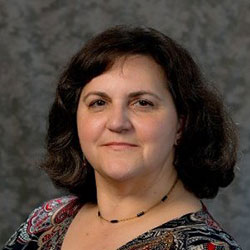Analytical Tools and Methods: Session III - Fate and Transport of Contaminants
Sponsored by: NIEHS Superfund Research Program
Archived: Monday, June 12, 2017
This webinar series highlights innovative analytical tools and methods developed and used by Superfund Research Program (SRP) grantees. The presenters will feature the benefits of these new tools and methods compared to conventional methods. They also will include information about how the technology has helped to facilitate ongoing SRP research.
During the third session of the series, speakers will highlight tools and methods to detect contaminants and measure their fate and transport in the environment. The speakers will highlight work related to polychlorinated biphenyls (PCBs), per- and polyfluoroalkyl substances (PFASs), chlorinated solvents, and other chemicals in the environment.
Keri Hornbuckle, Ph.D., professor of civil and environmental engineering at the University of Iowa, will discuss advances in the measurement of PCBs in complex environmental matrices. Her laboratory has developed methods for reproducible, accurate, and precise measurements of all 209 PCB congeners at sub-ppb levels in indoor and ambient air, water, soils, sediments, pore waters, plant tissues, and human blood serum. She will discuss methods for sampling, pressurized solid extraction, automated concentration and purification, detection using triple quadrupole mass spectrometry, and quality control and assurance methods that deliver whole method quantification limits less than 1 ng of total PCBs /sample.
Jennifer Guelfo, Ph.D., a postdoctoral researcher and State Agencies Liaison in the Brown SRP Center, will provide background related to PFASs and discuss key challenges and knowledge gaps related to fate and transport. She will also present an overview of PFAS occurrence in large-scale drinking water systems across the United States using data from EPA’s unregulated contaminant monitoring rule (UCMR)-3 collection effort. Lastly, she will introduce a collaborative effort between the Brown SRP and state regulators that is targeted at providing a user-friendly geospatial framework for identification of potential PFAS source zones.
Mark Brusseau, Ph.D., professor in the school of earth and environmental sciences at the University of Arizona, will describe the Integrated Contaminant Elution and Tracer (ICET) test for improved characterization of mass transfer, attenuation, and mass removal. Extensive and persistent groundwater contaminant plumes are widespread at sites contaminated by compounds such as chlorinated solvents, 1,4-dioxane, Methyl Tertiary Butyl Ether, and perfluorinated chemicals. Improved characterization methods are needed to delineate and quantify the processes and factors that contribute to plume persistence. This presentation will summarize the ICET test, with illustrative applications for characterizing constraints to mass removal.
Accessibility, Recording, and Content Disclaimer
Rehabilitation Act Notice for Reasonable Accommodation
It is EPA's policy to make reasonable accommodation to persons with disabilities wishing to participate in the agency's programs and activities, pursuant to the Rehabilitation Act of 1973, 29 U.S.C. 791. Any request for accommodation should be made to Sara Amolegbe at 919-213-4906 or samolegbe@michaeldbaker.com, preferably one week or more in advance of the webinar, so that EPA will have sufficient time to process the request. EPA would welcome specific recommendations from requestors specifying the nature or type of accommodation needed. Please note that CLU-IN provides both alternate phone call-in options and closed captioning for all webinars, and requests for these specific accommodations are not necessary.
Webinar Recording
By participating in this CLU-IN webinar, you automatically agree to authorize recording of audio and visual content presented during this live event and consent to subsequent use of this recording in the public domain by the U.S. Environmental Protection Agency. This recording may include questions, comments and poll responses provided by you during the live event in addition to your name, voice, image or likeness. This recording will be made available after the conclusion of the live event as part of the CLU-IN webinar archives, and will remain available indefinitely. If you do not wish to consent to the recording, please do not join the live event, and contact Jean Balent at 202-566-0832 or balent.jean@epa.gov to discuss your concerns.
Content Disclaimer
This webinar is intended solely to provide information to the public. The views and opinions expressed as part of this webinar do not necessarily state or reflect those of the U.S. Environmental Protection Agency. It is not intended, nor can it be relied upon, to create any rights enforceable by any party in litigation with the United States, or to endorse the use of products or services provided by specific vendors. With respect to this webinar, neither the United States Government nor any of their employees, makes any warranty, express or implied, including the warranties of merchantability and fitness for a particular purpose, or assumes any legal liability or responsibility for the accuracy, completeness, or usefulness of any information, apparatus, product, or process disclosed, or represents that its use would not infringe privately owned rights.
Presenters:
 Keri Hornbuckle, Ph.D., University of Iowa (keri-hornbuckle@uiowa.edu or 319-384-0789)
Keri Hornbuckle, Ph.D., University of Iowa (keri-hornbuckle@uiowa.edu or 319-384-0789)
Keri Hornbuckle is the director of the Iowa Superfund Research Program Center (ISRP) and leads Project 4 and the ISRP Analytical Core. She is the Donald E. Bently Professor of Engineering, Professor of Civil & Environmental Engineering, Professor of Occupational and Environmental Health, and serves on the faculty of the Interdisciplinary Graduate Program in Human Toxicology, all at the University of Iowa. Hornbuckle is an Associate Editor of Environmental Science & Technology. Her research includes large-scale field studies, development of novel sampling and analytical methods, and computational modeling to examine the sources, transport, and fate of persistent organic pollutants in indoor and outdoor environments.
 Jennifer Guelfo, Brown University (Jennifer_Guelfo@brown.edu or 225-223-1319)
Jennifer Guelfo, Brown University (Jennifer_Guelfo@brown.edu or 225-223-1319)
Jennifer Guelfo, Ph.D., is a postdoctoral researcher and State Agencies Liaison in the Brown Superfund Research Program. She is active in both research and research translation related to analysis, fate/transport, and remediation of contaminants in groundwater. Her current research focuses on understanding key physico-chemical variables governing fate, transport, and remediation of poly and perfluoroalkyl substances (PFASs) and development of user-friendly tools for geospatial identification of potential PFAS source zones. Dr. Guelfo completed her Ph.D. at the Colorado School of Mines (2013) studying PFAS fate and transport. She also has a combination of academic, consulting, and industry experience providing her with diverse perspectives in environmental management. She is interested in teaching and research that incorporates this interdisciplinary background and bridges gaps between researchers and practitioners through research translation to the broader scientific community.
 Mark Brusseau, University of Arizona (brusseau@email.arizona.edu or 520-621-3244)
Mark Brusseau, University of Arizona (brusseau@email.arizona.edu or 520-621-3244)
Mark Brusseau, Ph.D., is a professor in the School of Earth and Environmental Sciences at the University of Arizona, with appointments in the Soil, Water and Environmental Science Department (Home) and the Hydrology and Atmospheric Science Department (Joint). Dr. Brusseau is a member of several professional societies, and is a Fellow of the American Geophysical Union, of the Geological Society of America, and of the Soil Science Society of America. Dr. Brusseau's research is focused on developing a fundamental understanding of the factors and processes influencing the transport and fate of contaminants in the subsurface. He is also interested in the development and evaluation of innovative subsurface remediation and characterization technologies, and the evaluation of risks posed to human health by contamination.
Moderator:
 Felicia Barnett, U.S. Environmental Protection Agency (Barnett.Felicia@epa.gov or 404-562-8659)
Felicia Barnett, U.S. Environmental Protection Agency (Barnett.Felicia@epa.gov or 404-562-8659)
Felicia Barnett is the US Environmental Protection Agency (EPA) Director of the Site Characterization and Monitoring Technical Support Center (SCMTSC) responsible for site investigative technical support and the development and maintenance of ProUCL. She is also the Region 4 Superfund and Technology Liaison for the Office of Research and Development (ORD). Felicia is the ORD resource for characterization technologies/performance support to the EPA program and regional offices and research/engineering/liaison technical support to EPA Region 4 located in Atlanta, Georgia. She provides expertise to the Region's waste programs on investigative, subsurface/groundwater, and engineering technical support and innovative technologies, including pesticides, brownfields, wood treaters, metals, and phytoremediation along with national contacts within ORD for those and other fields/wastes.
She joined the EPA in 1985 as a Site Assessment Manager for the Superfund Program. She later worked as a Remedial Project Manager for Hazardous Waste Site cleanups and has worked for over twenty years in the Office of Research and Development.
Felicia holds a BS degree in Chemical Engineering from the University of Tennessee in Knoxville.
Webinar Slides and References:
- Slide Presentation for Keri Hornbuckle, Ph.D., University of Iowa:
- Slide Presentation for Jennifer Guelfo, Brown University:
-
 Slide Presentation for Mark Brusseau, University of Arizona (7.64MB/PDF)
Slide Presentation for Mark Brusseau, University of Arizona (7.64MB/PDF)
Webinar Slides and References:
- Slide Presentation for Keri Hornbuckle, Ph.D., University of Iowa:
- Slide Presentation for Jennifer Guelfo, Brown University:
-
 Slide Presentation for Mark Brusseau, University of Arizona (7.64MB/PDF)
Slide Presentation for Mark Brusseau, University of Arizona (7.64MB/PDF)
Additional Resources:
If you have a suggested topic or idea for a future CLU-IN internet seminar, please contact:
Technology Integration and Information Branch
PH: 202-566-0832 | Email: balent.jean@epa.gov
Technology Integration and Information Branch
PH: 202-566-0875 | Email: adam.michael@epa.gov





